The Bolduc House Cradle
This page is dedicated to my reproduction of a piece in the Bolduc House in Saint Genevieve, Missouri. Shannon and I visited St Genevieve on our 2009 roadtrip to see friends in Little Rock and St Louis. This charming french colonial town, settled in the mid 1700's, was a late-in-the-day rest on our journey between the two cities. Unfortunately by the time we got there the house museums were closed. But we spent a few hours before dusk walking around and actually got into one house thanks to some archeology students we met. We were really taken with the town - it was kind of like Williamsburg without the tourists. It was a real town where folks lived in and around 18th c. buildings that wasn't touristy in any way and wasn't in New England! Here are some of my shots of the house from our trip. Saab for scale.
.jpg)
.jpg)
.jpg)
.jpg)
.jpg)
.jpg)
The Bolduc House was the first authentically restored historic structure in St Genevieve. It was built in 1770 out near the river on the Le Grand Champ field by Louis Bolduc, a Canadian lead miner, merchant and planter. The house is of vertical log construction but is a post on solle or foundation. The stockade fence says "keep out". After the "great flood of 1783" the house was taken apart, and reassembled in its present location in 1784. See my architecture page for more pictures of the town.
When we found out we were going to be parents at the beginning of this year (2014) Shannon found a picture in a Better Homes book from the 1960's that had a cool looking cradle in it that happened to be from the Bolduc House. She contacted the museum curator - sure enough the cradle was still exactly where it was in the 1960's - who graciously took photos for me and some basic overall measurements. Here are some of the study photos:
.jpg)
.jpg)
.jpg)
.jpg)
.jpg)
.jpg)
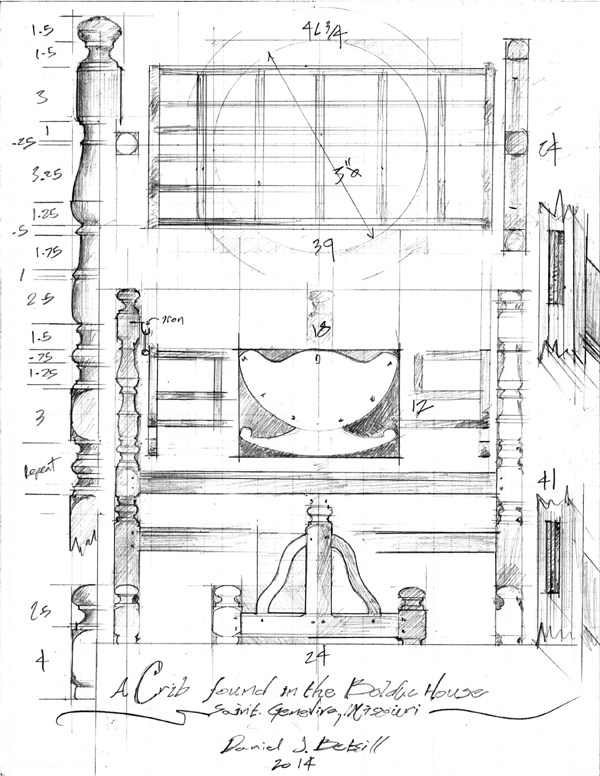
My drawing of the cradle (I kept calling it a Crib for some reason) with overall measurements written in as they were provided by the curator and my guesses based on the detail photos of the post turning measurements. Below, a photo of the room in which the cradle resides, from our Better Homes and Garden's book from the 1960's.
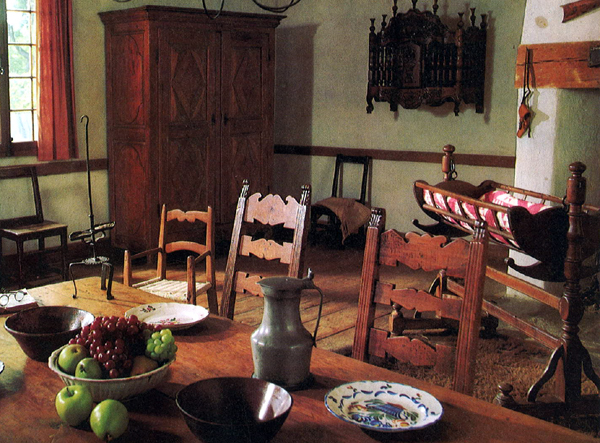
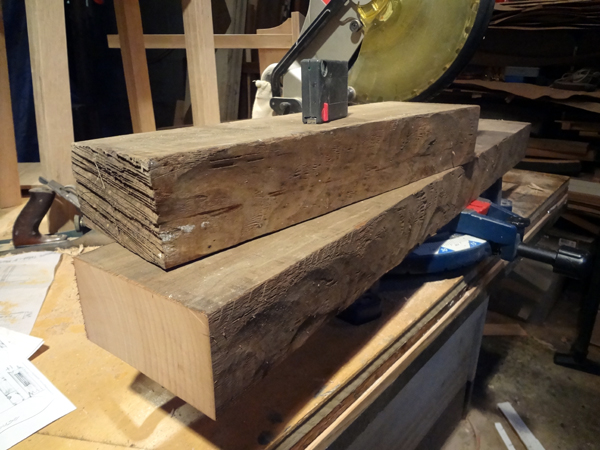
Most of the original crib is white oak, however the posts are some kind of closed-grain wood like cherry. I found some 3" thick cherry at Carlton McClendon which had its own story: hand adz marks. Who knows how old this is or where it came from, but it's old.

Tweaking the shape of the end panels.
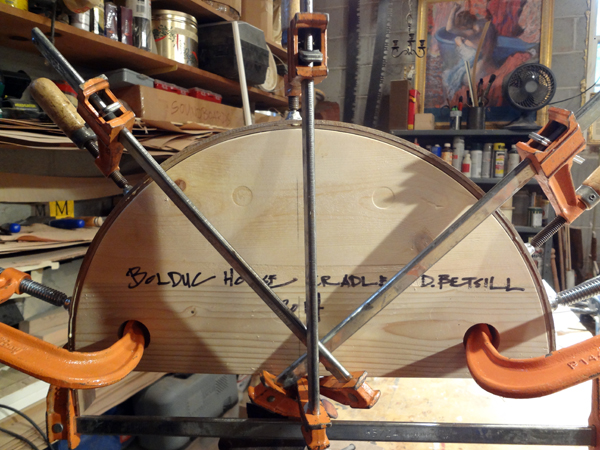
Bending two strips of quartersawn oak over a form to make one of the ribs.
.jpg)
While cutting strips for the fillets of the cradle basket I came across some insect holes that were perfectly spaced apart. Carpenter ants?
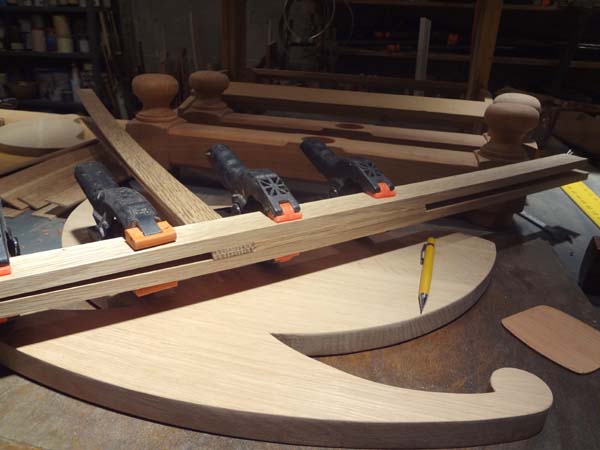
This is a fit-up of the basket with two thin layers of quartersawn white oak making the hoops sandwiched between two rail pieces with a fillet.

Test fitting the ribs to the rails.
.jpg)
Each rail is mortised into the end panels
.jpg)
A layup of the ribs and rails
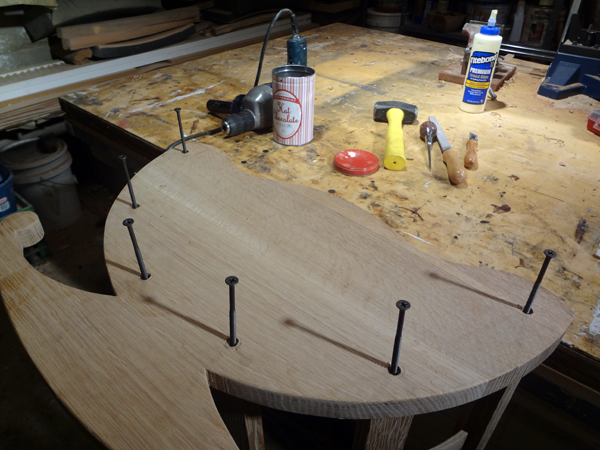
If French colonials had tightbond and 3" drywall screws, would they use them? I think yes.

The original appears to have some sort of tack securing each intersection on the basket. The original probably had its rails mortised to slide the staves through, unlike my version that has the rails built up out of pieces (the laminations also visible in this shot before I cleaned them up). So my tack is doing double duty by keeping the stave from sliding out but I'm using a brass tack that's just a little longer than the assembly so I can crimp it down on the inside face to ensure that the pieces never pull apart. The head embedded on the outside face makes a nice detail. God is in the details.

Turning the bun feet of the base. One down, three to go! Turning two at a time. I'll finish the head profile and do the final sanding after both are roughed out when I can worry less about deflection. I'll round the corners of the flats off the lathe.
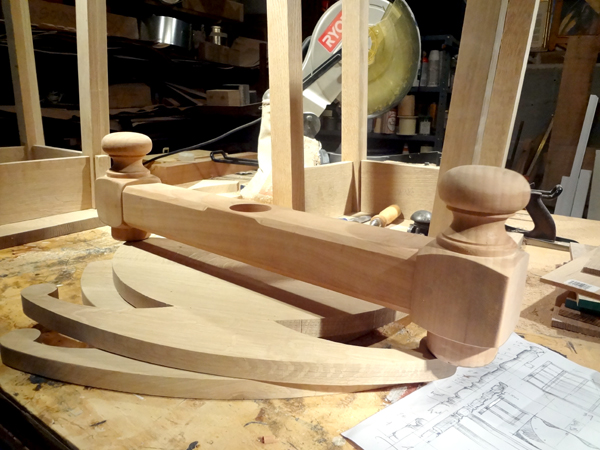
One of the foot assemblies complete with chamfered corners.
.jpg)
Beginning to turn the posts of the frame. Kind of an unfortunate place for a knot. I could go back to the lumber store and get another piece. But if I was doing this in the wilderness of pre-Louisiana Purchase colonial France I would probably not want to go out and cut down another tree. We'll call this a beauty mark.
.jpg)
The continuing story of my un-treadle lathe. This time I've had to clamp the tailstock outside the bed to get the 42" length I need for this piece.

Much mortise and tennoning later the frame is assembled. The basket has been stained with walnut husks. We're one month away from baby arrival!

To keep the finish 100% natural I'm using Van Dyke crystals (ground walnut husks) and a beeswax mixture I put together with turpentine and Rottenstone and some of the stain mixed in. This was such a pleasant experience making my own finishes and not having noxious fumes that I think I will start using this finish on my instruments.
++++++
Completed images in situ:
.jpg)
.jpg)
.jpg)
We were fortunate to have a blacksmith right here in Stone Mountain, Michael Labbe-Webb, to make replicas of the original forged hardware. The quilt is by Shannon's mom and the wall hanging is by her grandmother from when she was a baby.
.jpg)
.jpg)

Leaf and branch, water and stone: they have the hue and beauty of all these things under the twilight of Lorien that we love; for we put the thought of all that we love into all that we make.
- J.R.R Tolkien, from the Lord of the Rings
